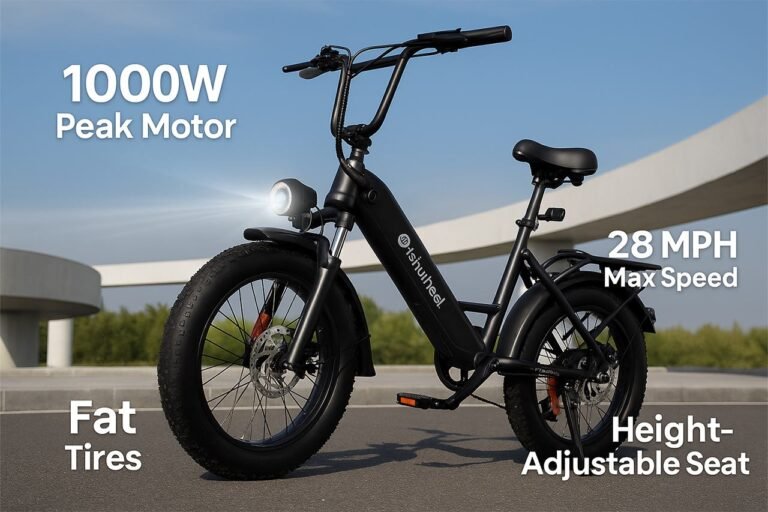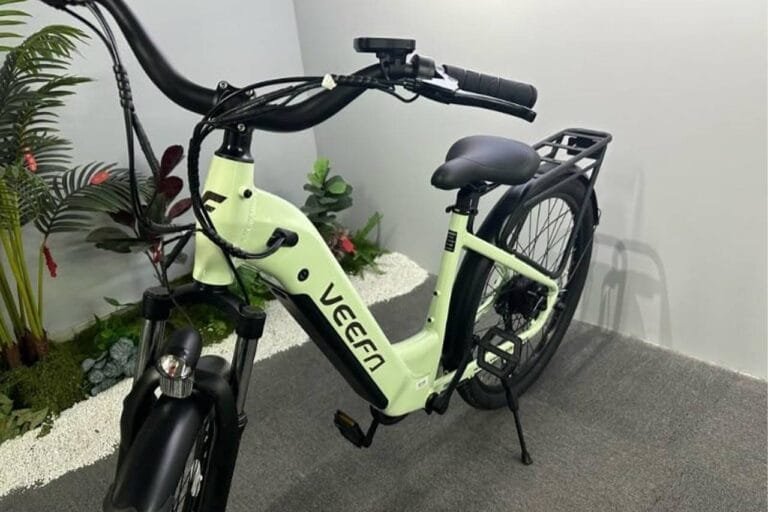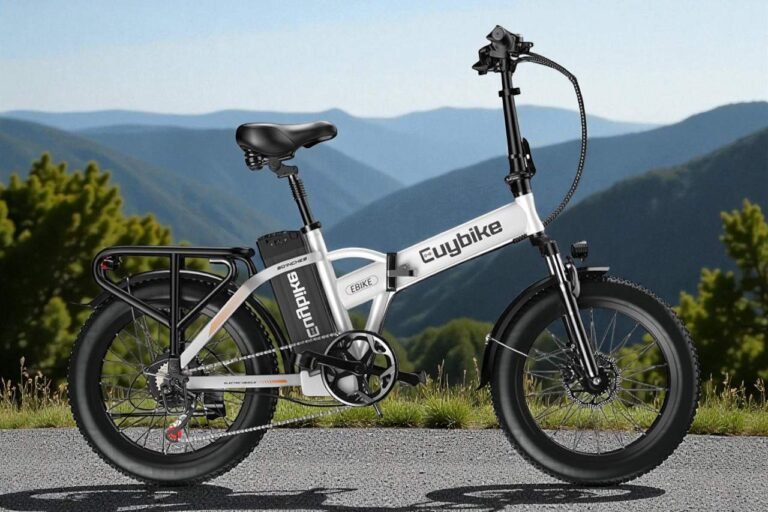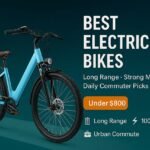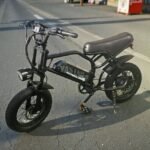![Top Folding E-Bikes Under $900 in [year]: Light, Long-Range, Ready to Commute Best Folding E-Bikes Under $900](https://goebikelife.com/wp-content/uploads/2024/08/Best-Folding-E-Bikes-Under-900.jpg)
Top 3 Picks — Best Folding E-Bikes Under $900 (2025)
A value winner, a performance option, and a balanced all-rounder—compare at a glance.
![Top Folding E-Bikes Under $900 in [year]: Light, Long-Range, Ready to Commute Cybervelo EK4 Folding E-Bike product image](https://goebikelife.com/wp-content/uploads/2024/08/Cybervelo-EK4.jpg)
Cybervelo EK4 — Big Battery, Daily Reliability
- 48V 20.8Ah battery—excellent range for commuters
- Stable 20×3.0 fat tires + front suspension
- Sensible spec: 7-speed, LCD, fold-and-go portability
![Top Folding E-Bikes Under $900 in [year]: Light, Long-Range, Ready to Commute Gotrax R1 Folding E-Bike product image](https://goebikelife.com/wp-content/uploads/2024/08/Gotrax-R1.jpg)
Gotrax R1 — Light, Simple, Affordable
- 45 lb class—easy to carry upstairs
- UL 2849 certified system for safety peace of mind
- Clean commuter spec: 7-speed, LCD, 20×2.6 tires
![Top Folding E-Bikes Under $900 in [year]: Light, Long-Range, Ready to Commute Jasion X-Hunter Folding E-Bike product image](https://goebikelife.com/wp-content/uploads/2024/08/Jasion-X-Hunter.jpg)
Jasion X-Hunter — Full-Suspension Fat-Tire
- Air fork + rear shock tame rough paths
- 20×4.0 tires for sand, gravel and snow
- Strong peak output for hills and starts
If you want a fun, compact, and genuinely useful e-bike without spending four figures, you’re in the right place. Folding e-bikes under $900 sit in a sweet spot: portable enough for apartments and trunks, powerful enough for daily rides, and feature-rich enough (racks, lights, gears, front suspension) to make commuting and weekend trips easy.
In this guide you’ll get:
- A quick-glance Top-3 comparison module to drop at the top of your post.
- Deep-dive mini-reviews of 5 excellent picks under $900.
- A practical buying framework (motor, battery, weight, fit, safety, support).
- Realistic range/speed expectations and legality tips.
- Setup, maintenance, and longevity advice that reduces returns and buyer’s remorse.
How to Choose a Folding E-Bike Under $900
1) Motor & Class
- In this bracket you’ll mostly see 350–500W nominal hub motors (peaks 750–1000W+). That’s plenty for flat city use and light hills.
- Expect Class 2 behavior (20 mph with throttle + PAS). Some models claim higher top speeds—always check your local e-bike rules and set the max speed accordingly.
2) Battery capacity & realistic range
- A common pack is 48V 7.8–10.4Ah (374–500 Wh), giving roughly 15–22 mi throttle or 25–55 mi PAS depending on rider weight, terrain and assist level.
- Larger packs (e.g., 48V 20Ah ≈ 960 Wh) can stretch to 60–80+ mi PAS in gentle conditions at low assist.
3) Weight & portability
- “Light” for folders is still ~45–55 lb; fat-tire or full-suspension folders push ~70+ lb. If you’ll carry it upstairs often, prioritize lighter builds like the Gotrax R1.
4) Tires & comfort
- 20×2.4–3.0 tires balance comfort and weight. 20×4.0 fat tires add grip and cush but increase weight/rolling resistance. A front fork is common; rear suspension is rare under $900 and adds weight/complexity.
5) Brakes & drivetrain
- Mechanical discs are standard here and fine with occasional pad tweaks. 7-speed drivetrains cover city gradients; keep the chain clean and tensioned.
6) Safety & certification
- Look for UL 2849 on the electrical system when available. Use the included charger, avoid overnight unattended charging, and store indoors.
7) Support, warranty & parts
- Brand support varies widely at this price. Favor bikes with accessible spares (tires, tubes, brake pads, chains) and clear warranty terms.
8) Legal & practical notes
- Many listings quote 30 mph capabilities. Riders should configure speed to match local Class rules (often 20–28 mph), especially where throttle usage is regulated.
The Picks (deep-dive mini-reviews)
1) Cybervelo EK4 — the balanced daily rider with big battery
Why it’s great: Among sub-$900 folders, EK4 stands out for its large 48V 20.8Ah battery, strong peak motor output, and everyday-sensible spec (20×3.0 tires, front suspension, dual disc brakes, LCD, 7-speed). The larger pack gives real headroom for commuters who’d like to ride most of the week on one charge in PAS-2/3.
Key specs:
- Motor: 1000W peak hub
- Battery: 48V 20.8Ah removable
- Range: up to 80–100 mi (ideal conditions)
- Tires: 20″ fat (3.0), disc brakes, front suspension
- Weight: ~72 lb stated
- Load: up to 330 lb
- Display: LCD with speed, mileage, battery, PAS levels
Ride experience & use-cases:
- Commute length: 5–25 mi/day with PAS and moderate hills.
- Surface: City streets, bike paths, gravel connectors; fat tires smooth potholes.
- Rider profile: You value range + stability more than ultralight carry weight.
What we like
- Battery headroom reduces charge anxiety; fewer cycles = longer pack life.
- Commuter-ready controls (7-speed, LCD, lighting).
- Plush ride with 20×3.0 rubber and a fork that takes the sting off.
Trade-offs
- Heavier than city-leaning folders—carrying up stairs is a workout.
- Fat-tire rolling resistance trims efficiency; aim for PAS-2/3, not throttle-only.
Bottom line: For shoppers who value range and simplicity, EK4 delivers an everyday folder that “just works” and doesn’t constantly need a charger.
2) Gotrax R1 — the lightweight value pick
Why it’s great: R1 hits the fundamentals: 48V system, 350W motor (peak ~500W), 20 mph Class 2, 20×2.6 tires, 7-speed, and a claimed 40 mi PAS—all in a package around 45 lb, which matters a lot if you’ll carry it up stairs or lift it into a trunk frequently. It’s also listed with UL 2849 certification—a strong trust signal for budget shoppers.
Key specs:
- Motor: 350W nominal (500W peak), Class-2 top-speed 20 mph
- Battery: 48V 7.8Ah; charge ~5.5 h; up to 40 mi PAS
- Tires: 20×2.6; LCD; 5 PAS levels; 7-speed
- Weight: ≈45 lb
Ride experience & use-cases:
- Commute length: 3–12 mi/day on PAS.
- Surface: Pavement, bike lanes, parks.
- Rider profile: You want portability and price first, with enough assist for flats and mild hills.
What we like
- Genuinely portable for a folder.
- Clean spec—shifts, brakes, and display deliver what commuters expect.
- Approachable Class 2 behavior for first-time riders.
Trade-offs
- Smaller battery than “big-pack” rivals—real-world PAS days will be shorter.
- Slimmer tires and no rear suspension: comfort is good, not plush.
Bottom line: If you want a starter folding e-bike that’s easy to carry and easy to live with, the R1 nails value basics without many surprises.
3) Jasion X-Hunter — performance punch & full-suspension feel
Why it’s great: X-Hunter goes brawny in this price class: air fork + rear shock, 20×4.0 fat tires, 48V 13Ah battery, and strong peak output with a claimed ~30 mph capability (configure to legal limits). It’s a mini adventure bike that still folds down when you need to stash it.
Key specs:
- Motor: high peak output; ~30 mph capability (configurable)
- Battery: 48V 13Ah removable
- Tires: 20×4.0 fat; dual suspension (air fork + rear shock)
- Drivetrain: 7-speed, disc brakes
Ride experience & use-cases:
- Commute length: 5–18 mi/day; comfortable on broken pavement.
- Surface: Mixed—city, packed dirt, boardwalks, light snow.
- Rider profile: You want traction, comfort, and hill punch over ultimate portability.
What we like
- Full-suspension comfort is rare under $900.
- 20×4.0 tires + power = confidence on rough paths and winter streets.
- Great “weekender” personality for beaches and parks.
Trade-offs
- Heavier; you’ll notice it when carrying.
- Fat-tire rolling drag reduces efficiency vs. 20×2.6–3.0 commuters.
Bottom line: For riders who want a folding bike that feels like a mini-ATB, the X-Hunter is a blast—just plan on a heavier carry.
4) Cuybike F6F — big-battery value twin (often listed under multiple storefronts)
This model appears with hardware similar to other 20×3.0/4.0 fat-tire folders: 48V 20Ah battery, 750–1000W peak motor claims, ~30 mph marketing, dual disc brakes, LCD, and a typical 7-speed setup. If you can land it under $900 with coupons, it’s a strong “range-first” option comparable to other big-battery folders on paper.
Worth noting:
- Battery: 48V 20Ah; up to 80 mi PAS claims (ideal conditions)
- Motor: 750–1000W peak; ~30 mph (configure to local rules)
- Tires: 20″ fat-tire, front suspension, LCD, disc brakes
- Warranty/returns vary by seller; check policy lines before purchase
Who it’s for: Riders who want range and value, are comfortable with basic wrenching, and will double-check seller policies before checkout.
5) Gotrax R2 — the step-up commuter from R1
R2 takes R1’s approachable package and bumps the spec: 500W motor, 48V 10.4Ah battery, 55 mi PAS claim, 20×3.0 tires, and front suspension. It’s still a Class-2-friendly commuter with UL notes on the listing, and a great pick when you like the R1 formula but want a bit more battery/motor headroom.
Key specs:
- Motor: 500W; 20 mph Class-2
- Battery: 48V 10.4Ah; up to ~55 mi PAS (shorter on throttle)
- Tires: 20×3.0, front shock, disc brakes, 7-speed
- Folded size: ~34.6×24×28.7 in (listed)
Who it’s for: Budget commuters who liked the R1 but want just a little more in motor torque and battery capacity while staying in the sub-$900 bracket during sale windows.
Which one should you buy?
Be decisive:
- Want the best daily range with a commuter-friendly feel? Cybervelo EK4.
- On a tight budget or need to carry it a lot? Gotrax R1.
- Crave comfort + off-pavement play in a foldable package? Jasion X-Hunter.
- Found a great coupon on a big-battery twin? Cuybike F6F is worth a look.
- Like Gotrax’s support but want more than R1? Gotrax R2.
Realistic range & speed
- Throttle-only on smaller packs (7.8–10.4Ah) typically delivers 12–20 mi.
- PAS-2/3 extends to 25–55 mi on mid-packs; 60–80 mi on big 20Ah packs if you keep assist low, pedal steadily, avoid big hills, and weigh less than ~180 lb.
- Listings that tout 30 mph are speaking to peak conditions. For city use, set speed to your local Class limit (often 20 mph throttle, up to 28 mph PAS for Class 3 zones).
Fit & comfort tips
- Seatpost & stem height: If you’re 5’3″–6’2″, most folders fit. Taller riders should verify max seatpost height and bar reach.
- Tire choice: 20×2.6–3.0 = nimbler, easier to pedal; 20×4.0 = cushier and more stable on bad roads.
- Suspension: Front forks absorb curbs and potholes; rear shocks add comfort but weight.
- Contact points: Swap to a gel saddle and ergonomic grips—cheap upgrades that boost satisfaction.
Safety & battery care
- Charge indoors with the included charger, stop at 100%, and don’t leave unattended overnight.
- Storage: Keep the battery at ~50–70% if you won’t ride for a month; store cool and dry.
- Inspection: Before each ride, check tire pressure, brake lever feel, and that the battery key is fully turned/locked (some models require a keyed “ON” position).
Assembly & setup
Most of these arrive 90–95% pre-assembled. You’ll install the handlebar, front wheel, pedals, and adjust the brakes/derailleur. Expect 30–60 minutes using the included tools and manual.
Pro tip: After the first 50–100 miles, re-check spoke tension, brake pad alignment, and derailleur limit screws; cables stretch slightly, and a quick tune keeps the bike quiet and crisp.
FAQs
Are high-peak-power folders legal in my city?
Most U.S. jurisdictions classify Class 2 at 20 mph with throttle. “30 mph” is a marketing headline; you can (and should) limit speed to stay compliant. Check local rules.
Can I ride in rain?
These bikes are typically water-resistant, not waterproof. Wet roads are fine; avoid submerging electronics or pressure-washing the frame.
How long do the batteries last?
Quality packs generally last 500–800 charge cycles before noticeable capacity loss. Bigger packs cycled less often can last longer in calendar time; store at ~50–70% when idle.
Which is easiest to carry?
The Gotrax R1 (around 45 lb) is the most portable in this group. The EK4 and X-Hunter are heavier but more comfortable on poor roads.
Mini comparison table
| Model | Battery | Claimed Range | Motor | Top Speed | Tires | Approx. Weight |
|---|---|---|---|---|---|---|
| Cybervelo EK4 | 48V 20.8Ah | up to ~80–100 mi (PAS, ideal) | 1000W peak | ~30 mph (config to legal) | 20×3.0 | ~72 lb |
| Gotrax R1 | 48V 7.8Ah | up to ~40 mi (PAS) | 350W (500W peak) | 20 mph | 20×2.6 | ~45 lb |
| Jasion X-Hunter | 48V 13Ah | — (varies by use) | high peak output | ~30 mph (config to legal) | 20×4.0 | ~71 lb |
| Cuybike F6F | 48V 20Ah | up to ~80 mi (PAS, ideal) | 750–1000W peak | 30+ mph (config to legal) | 20″ fat | — |
| Gotrax R2 | 48V 10.4Ah | up to ~55 mi (PAS) | 500W | 20 mph | 20×3.0 (front shock) | — |
Ranges are manufacturer claims under ideal conditions. Real-world results vary with rider weight, terrain, temperature, and PAS level.
Final verdict
- Best overall for most: Cybervelo EK4 — big battery, stable ride, daily-proof spec.
- Best budget/portable: Gotrax R1 — light and approachable; great first e-bike.
- Best performance feel: Jasion X-Hunter — fat-tire traction + full suspension fun.
- Solid big-battery alt: Cuybike F6F — watch for coupons and verify seller policies.
- Gotrax formula plus more: R2 — extra motor/battery headroom while staying Class-2 friendly.


